Financial Accounting Homework Assignment: Client Account Analysis
VerifiedAdded on 2023/01/06
|22
|3990
|32
Homework Assignment
AI Summary
This document presents a comprehensive solution to a financial accounting homework assignment, focusing on the preparation of financial statements and analysis of client accounts. The assignment covers various aspects of financial accounting, including the recording of financial transactions in journals and ledgers, as well as the creation of key financial statements like income statements, balance sheets, and cash flow statements. The solution demonstrates the application of accounting principles, such as accrual accounting and double-entry bookkeeping, through detailed examples and calculations. The assignment also includes an analysis of different stakeholders, both internal and external, and their impact on a business. Furthermore, it provides practical examples of accounting for sole traders, including journal entries, ledger accounts, and the preparation of financial statements for various clients. The solution covers topics such as sales, purchases, expenses, and payments, providing a clear understanding of the accounting process. The assignment also includes references to relevant accounting standards and principles, ensuring a strong foundation in financial accounting practices.
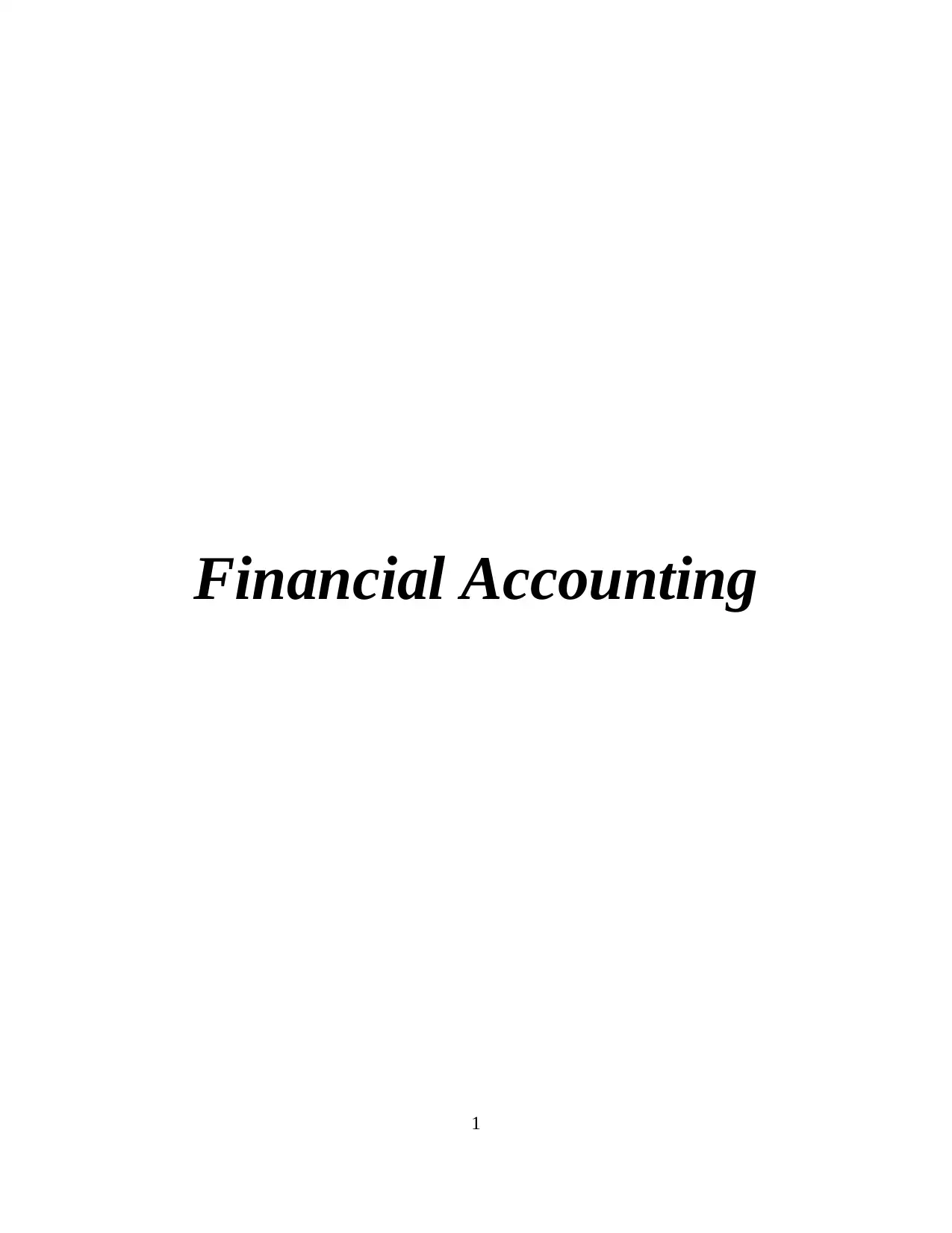
Financial Accounting
1
1
Paraphrase This Document
Need a fresh take? Get an instant paraphrase of this document with our AI Paraphraser
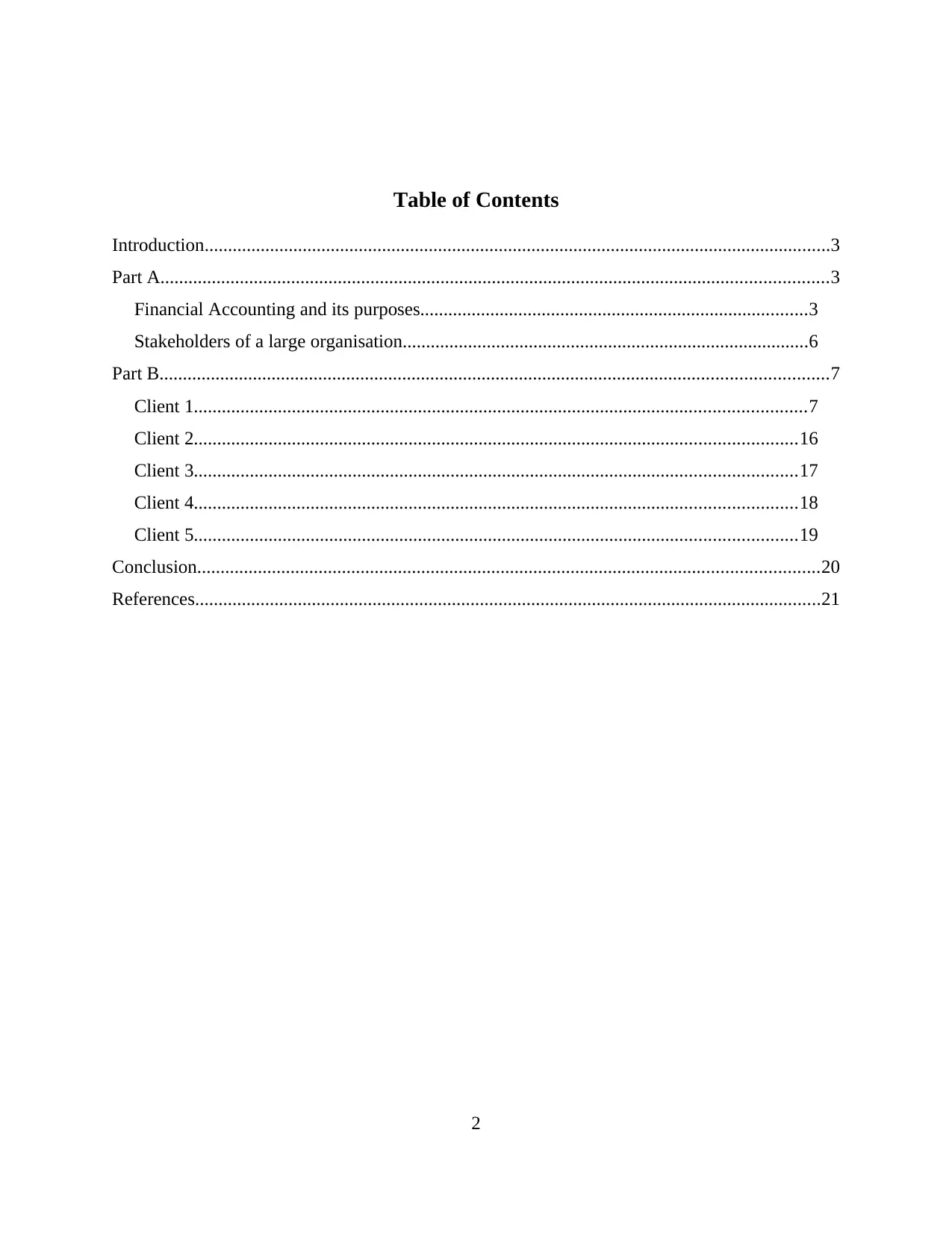
Table of Contents
Introduction......................................................................................................................................3
Part A...............................................................................................................................................3
Financial Accounting and its purposes...................................................................................3
Stakeholders of a large organisation.......................................................................................6
Part B...............................................................................................................................................7
Client 1...................................................................................................................................7
Client 2.................................................................................................................................16
Client 3.................................................................................................................................17
Client 4.................................................................................................................................18
Client 5.................................................................................................................................19
Conclusion.....................................................................................................................................20
References......................................................................................................................................21
2
Introduction......................................................................................................................................3
Part A...............................................................................................................................................3
Financial Accounting and its purposes...................................................................................3
Stakeholders of a large organisation.......................................................................................6
Part B...............................................................................................................................................7
Client 1...................................................................................................................................7
Client 2.................................................................................................................................16
Client 3.................................................................................................................................17
Client 4.................................................................................................................................18
Client 5.................................................................................................................................19
Conclusion.....................................................................................................................................20
References......................................................................................................................................21
2

Introduction
Financial accounting is related to the preparation and presentation of financial
information of a company's business performance. Purpose of financial accounting is financial
reporting (Birkenmaier Oliver and Huang, 2020). These reports reflects position and
performance of business to all its stakeholders. Stakeholders are parties that are interested in
affairs of the business. They can be internal or external for an organisation. They decide on their
course with company based on the financial reports. These reports include final accounts such as
income statement, balance sheet, cash flow statement, etc. Final accounts are drawn out of
recording financial transactions in books of accounts such as journal, ledgers, special subsidiary
books of accounts, trial balance, etc.
Part A
Financial Accounting and its purposes
Financial Accounting
Financial accounting is a branch of accounting that is concerned with recording,
summarising, analysing and presentation of financial transactions of a business. Transactions are
presented in financial statements such as income statement, Balance Sheet and cash flow
statement. All organisation have two kinds of stakeholders – internal and external. Internal
stakeholder includes owners, investors and employees of organisation while external
stakeholders include creditors, customers, government, etc. Financial accounting aims at
providing information to both external and internal stakeholder while management accounting is
concerned with only internal stakeholders (Flower and Ebbers, 2018).
Basis for comparison Financial Accounting Management Accounting
User It is used by both internal and
external stakeholders for
making their informed
business decision.
It is only for the use by internal
management of the
organisation to make relevant
business decisions
Contents It includes only those
transactions which are
financial in nature.
It is concerned with both
financial and non financial
information.
3
Financial accounting is related to the preparation and presentation of financial
information of a company's business performance. Purpose of financial accounting is financial
reporting (Birkenmaier Oliver and Huang, 2020). These reports reflects position and
performance of business to all its stakeholders. Stakeholders are parties that are interested in
affairs of the business. They can be internal or external for an organisation. They decide on their
course with company based on the financial reports. These reports include final accounts such as
income statement, balance sheet, cash flow statement, etc. Final accounts are drawn out of
recording financial transactions in books of accounts such as journal, ledgers, special subsidiary
books of accounts, trial balance, etc.
Part A
Financial Accounting and its purposes
Financial Accounting
Financial accounting is a branch of accounting that is concerned with recording,
summarising, analysing and presentation of financial transactions of a business. Transactions are
presented in financial statements such as income statement, Balance Sheet and cash flow
statement. All organisation have two kinds of stakeholders – internal and external. Internal
stakeholder includes owners, investors and employees of organisation while external
stakeholders include creditors, customers, government, etc. Financial accounting aims at
providing information to both external and internal stakeholder while management accounting is
concerned with only internal stakeholders (Flower and Ebbers, 2018).
Basis for comparison Financial Accounting Management Accounting
User It is used by both internal and
external stakeholders for
making their informed
business decision.
It is only for the use by internal
management of the
organisation to make relevant
business decisions
Contents It includes only those
transactions which are
financial in nature.
It is concerned with both
financial and non financial
information.
3
⊘ This is a preview!⊘
Do you want full access?
Subscribe today to unlock all pages.

Trusted by 1+ million students worldwide
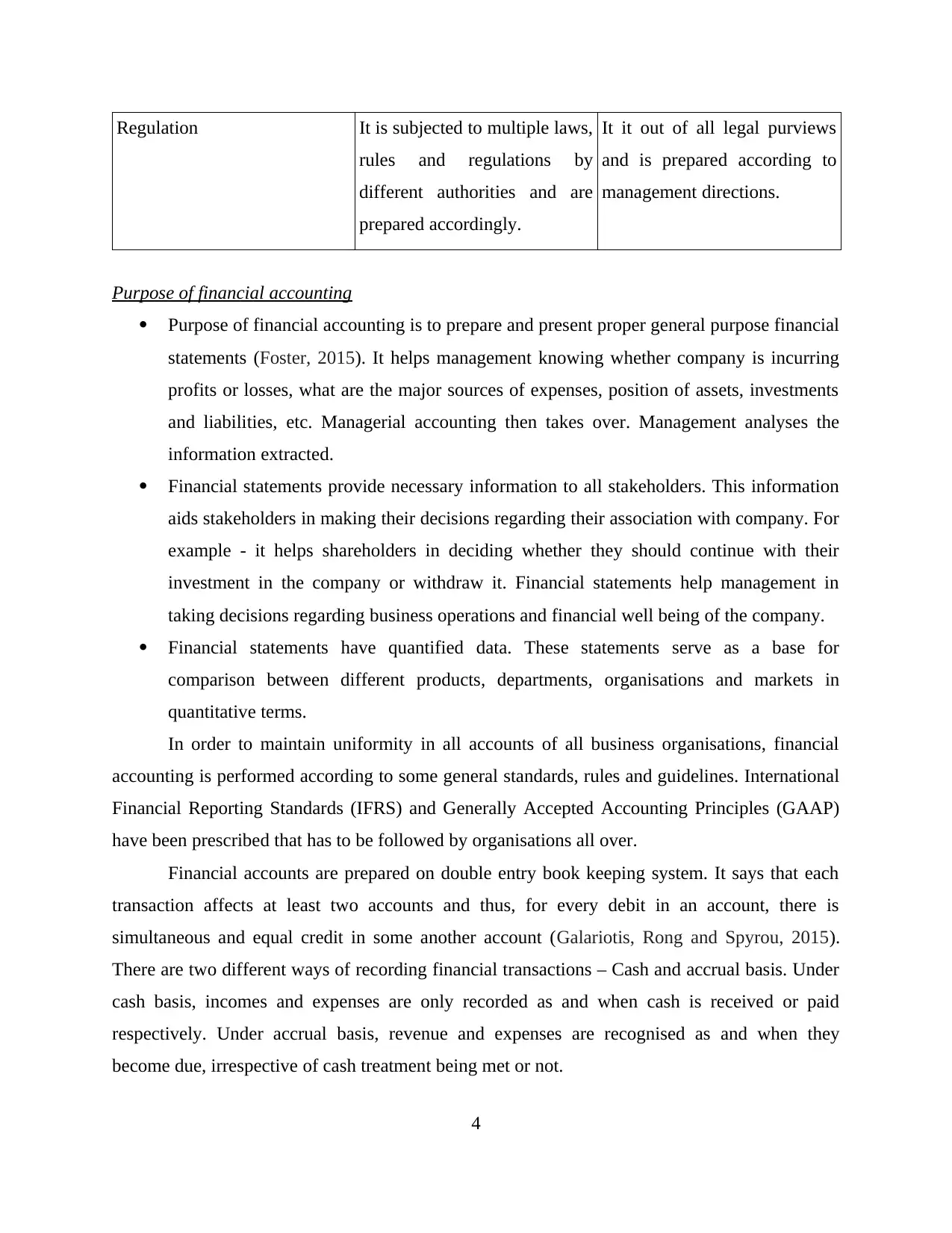
Regulation It is subjected to multiple laws,
rules and regulations by
different authorities and are
prepared accordingly.
It it out of all legal purviews
and is prepared according to
management directions.
Purpose of financial accounting
Purpose of financial accounting is to prepare and present proper general purpose financial
statements (Foster, 2015). It helps management knowing whether company is incurring
profits or losses, what are the major sources of expenses, position of assets, investments
and liabilities, etc. Managerial accounting then takes over. Management analyses the
information extracted.
Financial statements provide necessary information to all stakeholders. This information
aids stakeholders in making their decisions regarding their association with company. For
example - it helps shareholders in deciding whether they should continue with their
investment in the company or withdraw it. Financial statements help management in
taking decisions regarding business operations and financial well being of the company.
Financial statements have quantified data. These statements serve as a base for
comparison between different products, departments, organisations and markets in
quantitative terms.
In order to maintain uniformity in all accounts of all business organisations, financial
accounting is performed according to some general standards, rules and guidelines. International
Financial Reporting Standards (IFRS) and Generally Accepted Accounting Principles (GAAP)
have been prescribed that has to be followed by organisations all over.
Financial accounts are prepared on double entry book keeping system. It says that each
transaction affects at least two accounts and thus, for every debit in an account, there is
simultaneous and equal credit in some another account (Galariotis, Rong and Spyrou, 2015).
There are two different ways of recording financial transactions – Cash and accrual basis. Under
cash basis, incomes and expenses are only recorded as and when cash is received or paid
respectively. Under accrual basis, revenue and expenses are recognised as and when they
become due, irrespective of cash treatment being met or not.
4
rules and regulations by
different authorities and are
prepared accordingly.
It it out of all legal purviews
and is prepared according to
management directions.
Purpose of financial accounting
Purpose of financial accounting is to prepare and present proper general purpose financial
statements (Foster, 2015). It helps management knowing whether company is incurring
profits or losses, what are the major sources of expenses, position of assets, investments
and liabilities, etc. Managerial accounting then takes over. Management analyses the
information extracted.
Financial statements provide necessary information to all stakeholders. This information
aids stakeholders in making their decisions regarding their association with company. For
example - it helps shareholders in deciding whether they should continue with their
investment in the company or withdraw it. Financial statements help management in
taking decisions regarding business operations and financial well being of the company.
Financial statements have quantified data. These statements serve as a base for
comparison between different products, departments, organisations and markets in
quantitative terms.
In order to maintain uniformity in all accounts of all business organisations, financial
accounting is performed according to some general standards, rules and guidelines. International
Financial Reporting Standards (IFRS) and Generally Accepted Accounting Principles (GAAP)
have been prescribed that has to be followed by organisations all over.
Financial accounts are prepared on double entry book keeping system. It says that each
transaction affects at least two accounts and thus, for every debit in an account, there is
simultaneous and equal credit in some another account (Galariotis, Rong and Spyrou, 2015).
There are two different ways of recording financial transactions – Cash and accrual basis. Under
cash basis, incomes and expenses are only recorded as and when cash is received or paid
respectively. Under accrual basis, revenue and expenses are recognised as and when they
become due, irrespective of cash treatment being met or not.
4
Paraphrase This Document
Need a fresh take? Get an instant paraphrase of this document with our AI Paraphraser
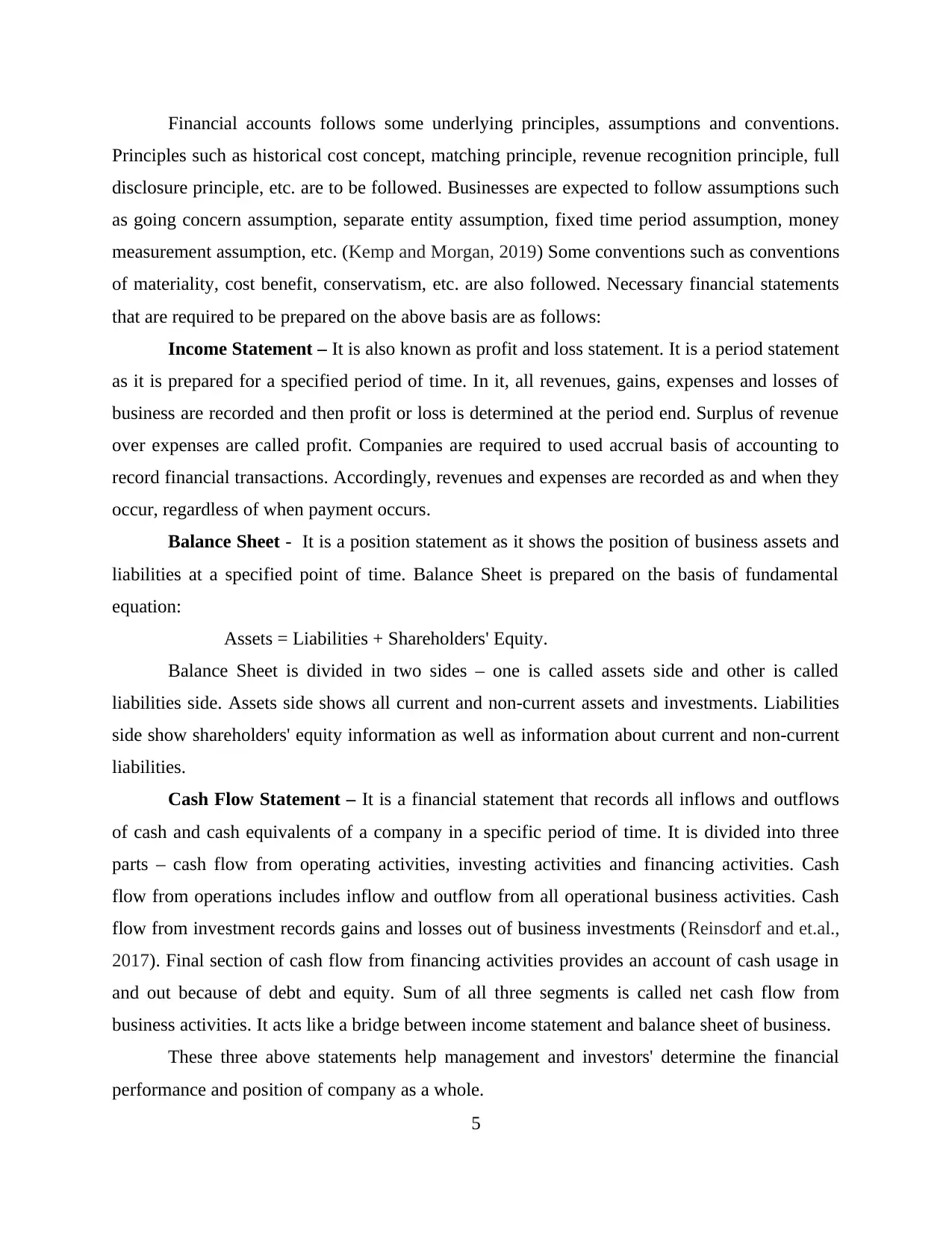
Financial accounts follows some underlying principles, assumptions and conventions.
Principles such as historical cost concept, matching principle, revenue recognition principle, full
disclosure principle, etc. are to be followed. Businesses are expected to follow assumptions such
as going concern assumption, separate entity assumption, fixed time period assumption, money
measurement assumption, etc. (Kemp and Morgan, 2019) Some conventions such as conventions
of materiality, cost benefit, conservatism, etc. are also followed. Necessary financial statements
that are required to be prepared on the above basis are as follows:
Income Statement – It is also known as profit and loss statement. It is a period statement
as it is prepared for a specified period of time. In it, all revenues, gains, expenses and losses of
business are recorded and then profit or loss is determined at the period end. Surplus of revenue
over expenses are called profit. Companies are required to used accrual basis of accounting to
record financial transactions. Accordingly, revenues and expenses are recorded as and when they
occur, regardless of when payment occurs.
Balance Sheet - It is a position statement as it shows the position of business assets and
liabilities at a specified point of time. Balance Sheet is prepared on the basis of fundamental
equation:
Assets = Liabilities + Shareholders' Equity.
Balance Sheet is divided in two sides – one is called assets side and other is called
liabilities side. Assets side shows all current and non-current assets and investments. Liabilities
side show shareholders' equity information as well as information about current and non-current
liabilities.
Cash Flow Statement – It is a financial statement that records all inflows and outflows
of cash and cash equivalents of a company in a specific period of time. It is divided into three
parts – cash flow from operating activities, investing activities and financing activities. Cash
flow from operations includes inflow and outflow from all operational business activities. Cash
flow from investment records gains and losses out of business investments (Reinsdorf and et.al.,
2017). Final section of cash flow from financing activities provides an account of cash usage in
and out because of debt and equity. Sum of all three segments is called net cash flow from
business activities. It acts like a bridge between income statement and balance sheet of business.
These three above statements help management and investors' determine the financial
performance and position of company as a whole.
5
Principles such as historical cost concept, matching principle, revenue recognition principle, full
disclosure principle, etc. are to be followed. Businesses are expected to follow assumptions such
as going concern assumption, separate entity assumption, fixed time period assumption, money
measurement assumption, etc. (Kemp and Morgan, 2019) Some conventions such as conventions
of materiality, cost benefit, conservatism, etc. are also followed. Necessary financial statements
that are required to be prepared on the above basis are as follows:
Income Statement – It is also known as profit and loss statement. It is a period statement
as it is prepared for a specified period of time. In it, all revenues, gains, expenses and losses of
business are recorded and then profit or loss is determined at the period end. Surplus of revenue
over expenses are called profit. Companies are required to used accrual basis of accounting to
record financial transactions. Accordingly, revenues and expenses are recorded as and when they
occur, regardless of when payment occurs.
Balance Sheet - It is a position statement as it shows the position of business assets and
liabilities at a specified point of time. Balance Sheet is prepared on the basis of fundamental
equation:
Assets = Liabilities + Shareholders' Equity.
Balance Sheet is divided in two sides – one is called assets side and other is called
liabilities side. Assets side shows all current and non-current assets and investments. Liabilities
side show shareholders' equity information as well as information about current and non-current
liabilities.
Cash Flow Statement – It is a financial statement that records all inflows and outflows
of cash and cash equivalents of a company in a specific period of time. It is divided into three
parts – cash flow from operating activities, investing activities and financing activities. Cash
flow from operations includes inflow and outflow from all operational business activities. Cash
flow from investment records gains and losses out of business investments (Reinsdorf and et.al.,
2017). Final section of cash flow from financing activities provides an account of cash usage in
and out because of debt and equity. Sum of all three segments is called net cash flow from
business activities. It acts like a bridge between income statement and balance sheet of business.
These three above statements help management and investors' determine the financial
performance and position of company as a whole.
5
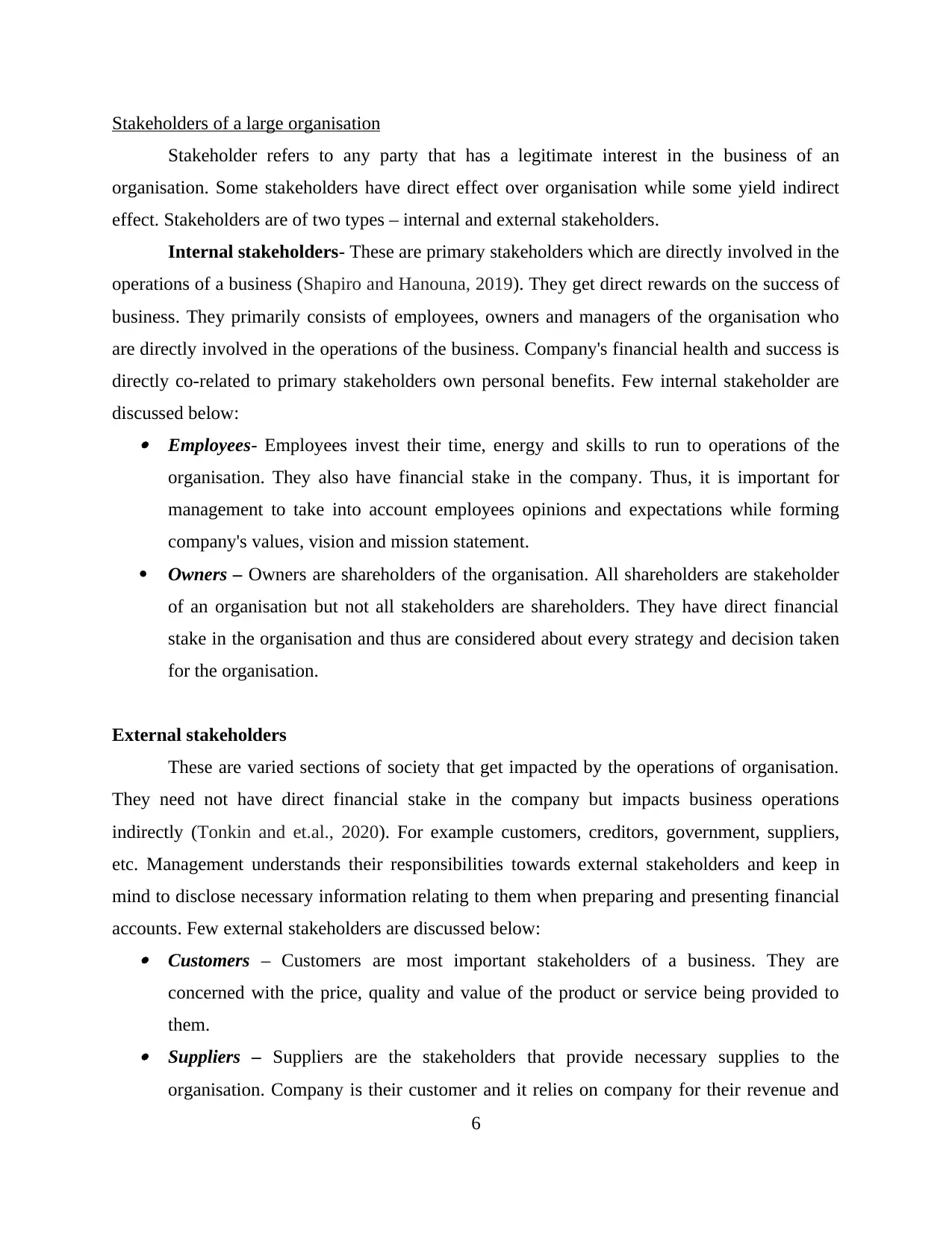
Stakeholders of a large organisation
Stakeholder refers to any party that has a legitimate interest in the business of an
organisation. Some stakeholders have direct effect over organisation while some yield indirect
effect. Stakeholders are of two types – internal and external stakeholders.
Internal stakeholders- These are primary stakeholders which are directly involved in the
operations of a business (Shapiro and Hanouna, 2019). They get direct rewards on the success of
business. They primarily consists of employees, owners and managers of the organisation who
are directly involved in the operations of the business. Company's financial health and success is
directly co-related to primary stakeholders own personal benefits. Few internal stakeholder are
discussed below: Employees- Employees invest their time, energy and skills to run to operations of the
organisation. They also have financial stake in the company. Thus, it is important for
management to take into account employees opinions and expectations while forming
company's values, vision and mission statement.
Owners – Owners are shareholders of the organisation. All shareholders are stakeholder
of an organisation but not all stakeholders are shareholders. They have direct financial
stake in the organisation and thus are considered about every strategy and decision taken
for the organisation.
External stakeholders
These are varied sections of society that get impacted by the operations of organisation.
They need not have direct financial stake in the company but impacts business operations
indirectly (Tonkin and et.al., 2020). For example customers, creditors, government, suppliers,
etc. Management understands their responsibilities towards external stakeholders and keep in
mind to disclose necessary information relating to them when preparing and presenting financial
accounts. Few external stakeholders are discussed below: Customers – Customers are most important stakeholders of a business. They are
concerned with the price, quality and value of the product or service being provided to
them. Suppliers – Suppliers are the stakeholders that provide necessary supplies to the
organisation. Company is their customer and it relies on company for their revenue and
6
Stakeholder refers to any party that has a legitimate interest in the business of an
organisation. Some stakeholders have direct effect over organisation while some yield indirect
effect. Stakeholders are of two types – internal and external stakeholders.
Internal stakeholders- These are primary stakeholders which are directly involved in the
operations of a business (Shapiro and Hanouna, 2019). They get direct rewards on the success of
business. They primarily consists of employees, owners and managers of the organisation who
are directly involved in the operations of the business. Company's financial health and success is
directly co-related to primary stakeholders own personal benefits. Few internal stakeholder are
discussed below: Employees- Employees invest their time, energy and skills to run to operations of the
organisation. They also have financial stake in the company. Thus, it is important for
management to take into account employees opinions and expectations while forming
company's values, vision and mission statement.
Owners – Owners are shareholders of the organisation. All shareholders are stakeholder
of an organisation but not all stakeholders are shareholders. They have direct financial
stake in the organisation and thus are considered about every strategy and decision taken
for the organisation.
External stakeholders
These are varied sections of society that get impacted by the operations of organisation.
They need not have direct financial stake in the company but impacts business operations
indirectly (Tonkin and et.al., 2020). For example customers, creditors, government, suppliers,
etc. Management understands their responsibilities towards external stakeholders and keep in
mind to disclose necessary information relating to them when preparing and presenting financial
accounts. Few external stakeholders are discussed below: Customers – Customers are most important stakeholders of a business. They are
concerned with the price, quality and value of the product or service being provided to
them. Suppliers – Suppliers are the stakeholders that provide necessary supplies to the
organisation. Company is their customer and it relies on company for their revenue and
6
⊘ This is a preview!⊘
Do you want full access?
Subscribe today to unlock all pages.

Trusted by 1+ million students worldwide

income. That's why they are interested in knowing about the financial health of the
company.
Government – Corporate tax form a good source of revenue for government. Also, it
provides employment to numerous people and employees working in it pay income tax to
government. Company also pays other indirect taxes and contributes in Gross Domestic
Product of country (Tunç and et.al., 2020). Larger and more sound the company is, more
is its contribution to the country. Thus, government keeps close observations on financial
performance of businesses.
Society – Companies derive its resources from society and in return, provides them
employment, economic development, healthcare and safety, etc. Company's entry and
exit from a society impacts its directly and indirectly. That's why society is always
looking for performance of the company.
Part B
Client 1
Popovski Store is a sole trader and requires books of accounts for the June 2020.
Journal – Journal is first book of accounts in which all financial transactions of a
business are recorded and then transferred to their respective ledger accounts.
Journal of Popvski Store
(for the month of June 2020)
Date Particulars L.F. Debit (in GBP) Credit (in GBP)
01/06/20 Storage Cost A/c Dr.
To Bank A/c
(being storage cost paid by cheque)
760
760
02/06/20 Purchases A/c Dr.
To S Hut
To D Main
To W Tone
To R Foot
(being goods purchased on credit)
6820
1450
2800
1320
1250
7
company.
Government – Corporate tax form a good source of revenue for government. Also, it
provides employment to numerous people and employees working in it pay income tax to
government. Company also pays other indirect taxes and contributes in Gross Domestic
Product of country (Tunç and et.al., 2020). Larger and more sound the company is, more
is its contribution to the country. Thus, government keeps close observations on financial
performance of businesses.
Society – Companies derive its resources from society and in return, provides them
employment, economic development, healthcare and safety, etc. Company's entry and
exit from a society impacts its directly and indirectly. That's why society is always
looking for performance of the company.
Part B
Client 1
Popovski Store is a sole trader and requires books of accounts for the June 2020.
Journal – Journal is first book of accounts in which all financial transactions of a
business are recorded and then transferred to their respective ledger accounts.
Journal of Popvski Store
(for the month of June 2020)
Date Particulars L.F. Debit (in GBP) Credit (in GBP)
01/06/20 Storage Cost A/c Dr.
To Bank A/c
(being storage cost paid by cheque)
760
760
02/06/20 Purchases A/c Dr.
To S Hut
To D Main
To W Tone
To R Foot
(being goods purchased on credit)
6820
1450
2800
1320
1250
7
Paraphrase This Document
Need a fresh take? Get an instant paraphrase of this document with our AI Paraphraser

03/06/20 J Wilson A/c Dr.
T. Cole A/c Dr.
F. Syme A/c Dr.
J. Allen A/c Dr.
P. White A/c Dr.
F. Leary A/c Dr.
To Sales A/c
(being goods sold on credit)
1600
1850
2600
1300
2500
1300
11150
04/06/20 Motor Expenses A/c Dr.
To Cash A/c
(being motor expenses paid in cash)
650
650
07/06/20 Drawings A/c Dr.
To Cash A/c
(being cash withdrawn for personal use)
1800
1800
09/06/20 T. Cole A/c Dr.
J. Fox A/c Dr.
To Sales A/c
(being goods sold on credit)
920
1850
2770
11/06/20 Sales Return A/c Dr.
To J. Wilson A/c
To F. Syme A/c
(being goods returned by debtors)
880
380
500
16/06/20 Cash A/c Dr.
To P. Weets A/c
To F. Leary A/c
To J. Wilson A/c
To F. Syme A/c
(being payment received from debtors)
10100
2800
4900
1250
1150
19/06/20 R. Foot A/c Dr. 260
8
T. Cole A/c Dr.
F. Syme A/c Dr.
J. Allen A/c Dr.
P. White A/c Dr.
F. Leary A/c Dr.
To Sales A/c
(being goods sold on credit)
1600
1850
2600
1300
2500
1300
11150
04/06/20 Motor Expenses A/c Dr.
To Cash A/c
(being motor expenses paid in cash)
650
650
07/06/20 Drawings A/c Dr.
To Cash A/c
(being cash withdrawn for personal use)
1800
1800
09/06/20 T. Cole A/c Dr.
J. Fox A/c Dr.
To Sales A/c
(being goods sold on credit)
920
1850
2770
11/06/20 Sales Return A/c Dr.
To J. Wilson A/c
To F. Syme A/c
(being goods returned by debtors)
880
380
500
16/06/20 Cash A/c Dr.
To P. Weets A/c
To F. Leary A/c
To J. Wilson A/c
To F. Syme A/c
(being payment received from debtors)
10100
2800
4900
1250
1150
19/06/20 R. Foot A/c Dr. 260
8
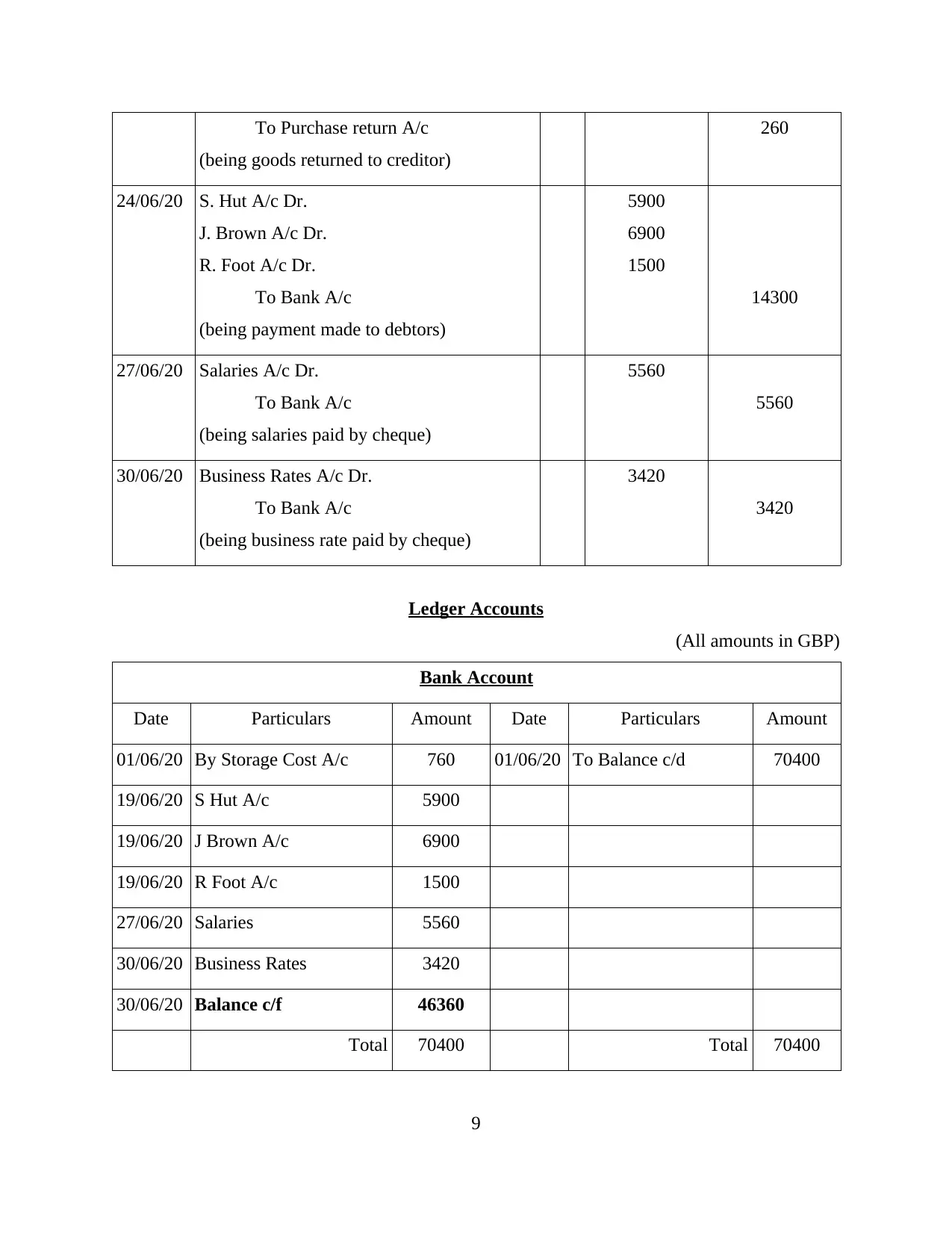
To Purchase return A/c
(being goods returned to creditor)
260
24/06/20 S. Hut A/c Dr.
J. Brown A/c Dr.
R. Foot A/c Dr.
To Bank A/c
(being payment made to debtors)
5900
6900
1500
14300
27/06/20 Salaries A/c Dr.
To Bank A/c
(being salaries paid by cheque)
5560
5560
30/06/20 Business Rates A/c Dr.
To Bank A/c
(being business rate paid by cheque)
3420
3420
Ledger Accounts
(All amounts in GBP)
Bank Account
Date Particulars Amount Date Particulars Amount
01/06/20 By Storage Cost A/c 760 01/06/20 To Balance c/d 70400
19/06/20 S Hut A/c 5900
19/06/20 J Brown A/c 6900
19/06/20 R Foot A/c 1500
27/06/20 Salaries 5560
30/06/20 Business Rates 3420
30/06/20 Balance c/f 46360
Total 70400 Total 70400
9
(being goods returned to creditor)
260
24/06/20 S. Hut A/c Dr.
J. Brown A/c Dr.
R. Foot A/c Dr.
To Bank A/c
(being payment made to debtors)
5900
6900
1500
14300
27/06/20 Salaries A/c Dr.
To Bank A/c
(being salaries paid by cheque)
5560
5560
30/06/20 Business Rates A/c Dr.
To Bank A/c
(being business rate paid by cheque)
3420
3420
Ledger Accounts
(All amounts in GBP)
Bank Account
Date Particulars Amount Date Particulars Amount
01/06/20 By Storage Cost A/c 760 01/06/20 To Balance c/d 70400
19/06/20 S Hut A/c 5900
19/06/20 J Brown A/c 6900
19/06/20 R Foot A/c 1500
27/06/20 Salaries 5560
30/06/20 Business Rates 3420
30/06/20 Balance c/f 46360
Total 70400 Total 70400
9
⊘ This is a preview!⊘
Do you want full access?
Subscribe today to unlock all pages.

Trusted by 1+ million students worldwide
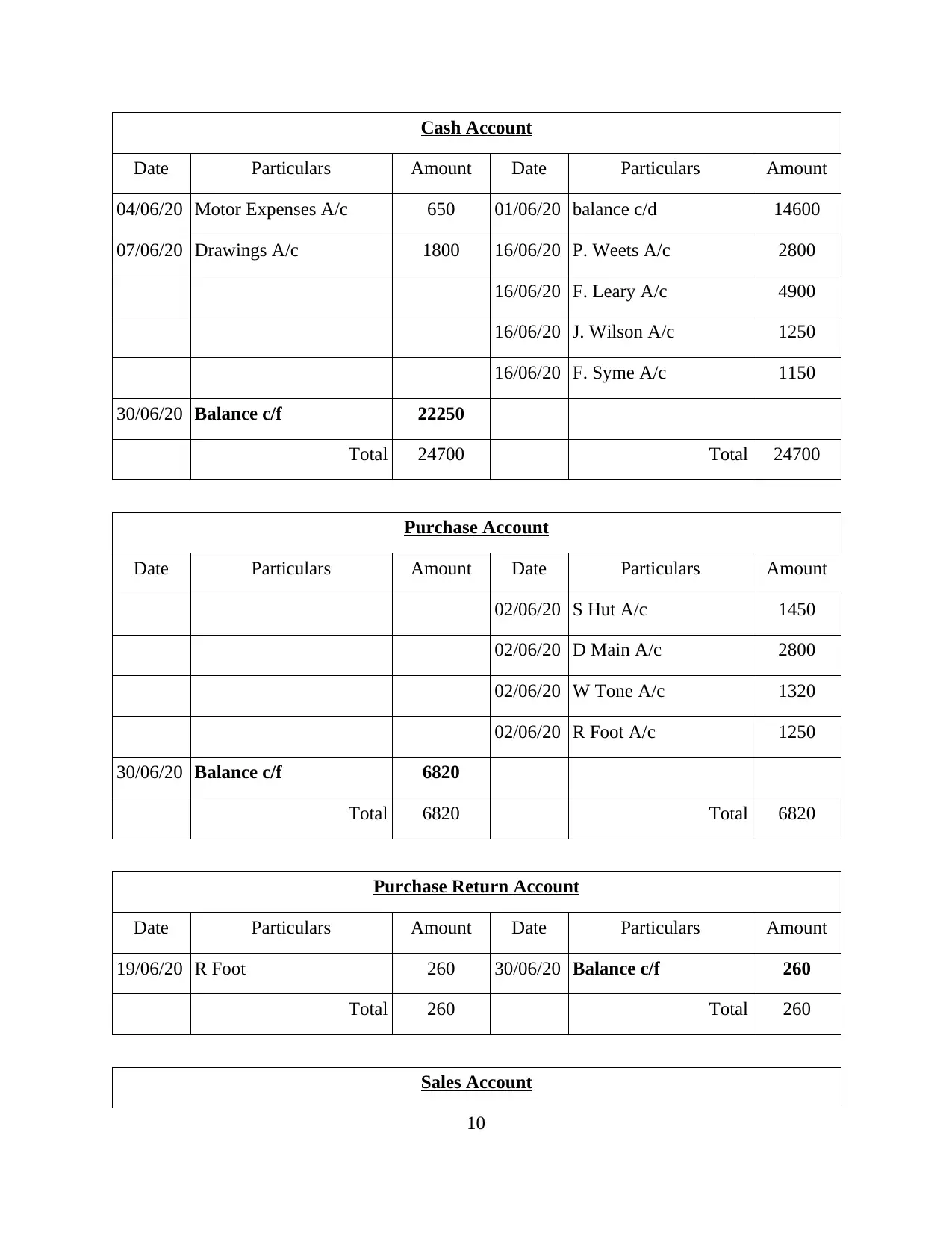
Cash Account
Date Particulars Amount Date Particulars Amount
04/06/20 Motor Expenses A/c 650 01/06/20 balance c/d 14600
07/06/20 Drawings A/c 1800 16/06/20 P. Weets A/c 2800
16/06/20 F. Leary A/c 4900
16/06/20 J. Wilson A/c 1250
16/06/20 F. Syme A/c 1150
30/06/20 Balance c/f 22250
Total 24700 Total 24700
Purchase Account
Date Particulars Amount Date Particulars Amount
02/06/20 S Hut A/c 1450
02/06/20 D Main A/c 2800
02/06/20 W Tone A/c 1320
02/06/20 R Foot A/c 1250
30/06/20 Balance c/f 6820
Total 6820 Total 6820
Purchase Return Account
Date Particulars Amount Date Particulars Amount
19/06/20 R Foot 260 30/06/20 Balance c/f 260
Total 260 Total 260
Sales Account
10
Date Particulars Amount Date Particulars Amount
04/06/20 Motor Expenses A/c 650 01/06/20 balance c/d 14600
07/06/20 Drawings A/c 1800 16/06/20 P. Weets A/c 2800
16/06/20 F. Leary A/c 4900
16/06/20 J. Wilson A/c 1250
16/06/20 F. Syme A/c 1150
30/06/20 Balance c/f 22250
Total 24700 Total 24700
Purchase Account
Date Particulars Amount Date Particulars Amount
02/06/20 S Hut A/c 1450
02/06/20 D Main A/c 2800
02/06/20 W Tone A/c 1320
02/06/20 R Foot A/c 1250
30/06/20 Balance c/f 6820
Total 6820 Total 6820
Purchase Return Account
Date Particulars Amount Date Particulars Amount
19/06/20 R Foot 260 30/06/20 Balance c/f 260
Total 260 Total 260
Sales Account
10
Paraphrase This Document
Need a fresh take? Get an instant paraphrase of this document with our AI Paraphraser
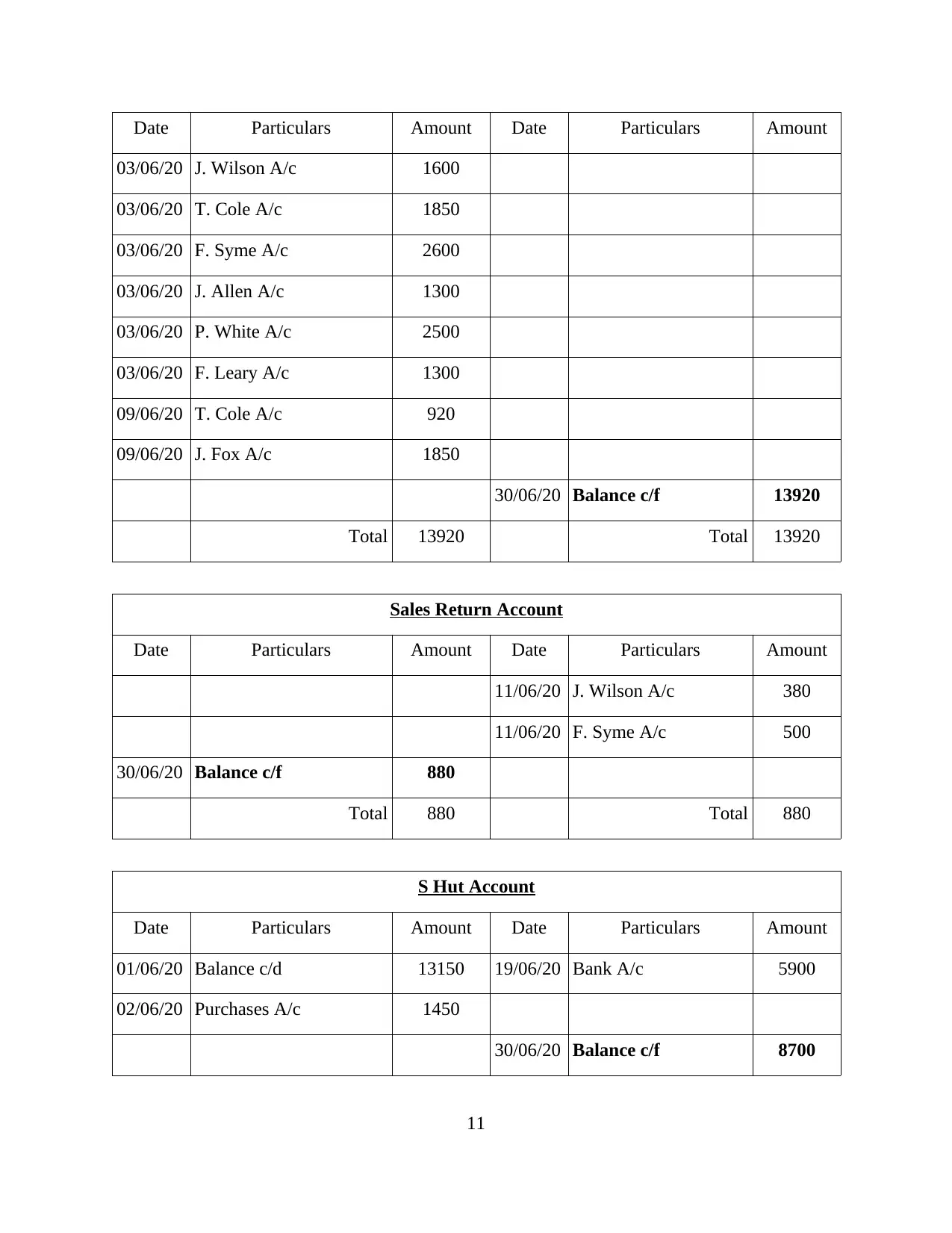
Date Particulars Amount Date Particulars Amount
03/06/20 J. Wilson A/c 1600
03/06/20 T. Cole A/c 1850
03/06/20 F. Syme A/c 2600
03/06/20 J. Allen A/c 1300
03/06/20 P. White A/c 2500
03/06/20 F. Leary A/c 1300
09/06/20 T. Cole A/c 920
09/06/20 J. Fox A/c 1850
30/06/20 Balance c/f 13920
Total 13920 Total 13920
Sales Return Account
Date Particulars Amount Date Particulars Amount
11/06/20 J. Wilson A/c 380
11/06/20 F. Syme A/c 500
30/06/20 Balance c/f 880
Total 880 Total 880
S Hut Account
Date Particulars Amount Date Particulars Amount
01/06/20 Balance c/d 13150 19/06/20 Bank A/c 5900
02/06/20 Purchases A/c 1450
30/06/20 Balance c/f 8700
11
03/06/20 J. Wilson A/c 1600
03/06/20 T. Cole A/c 1850
03/06/20 F. Syme A/c 2600
03/06/20 J. Allen A/c 1300
03/06/20 P. White A/c 2500
03/06/20 F. Leary A/c 1300
09/06/20 T. Cole A/c 920
09/06/20 J. Fox A/c 1850
30/06/20 Balance c/f 13920
Total 13920 Total 13920
Sales Return Account
Date Particulars Amount Date Particulars Amount
11/06/20 J. Wilson A/c 380
11/06/20 F. Syme A/c 500
30/06/20 Balance c/f 880
Total 880 Total 880
S Hut Account
Date Particulars Amount Date Particulars Amount
01/06/20 Balance c/d 13150 19/06/20 Bank A/c 5900
02/06/20 Purchases A/c 1450
30/06/20 Balance c/f 8700
11
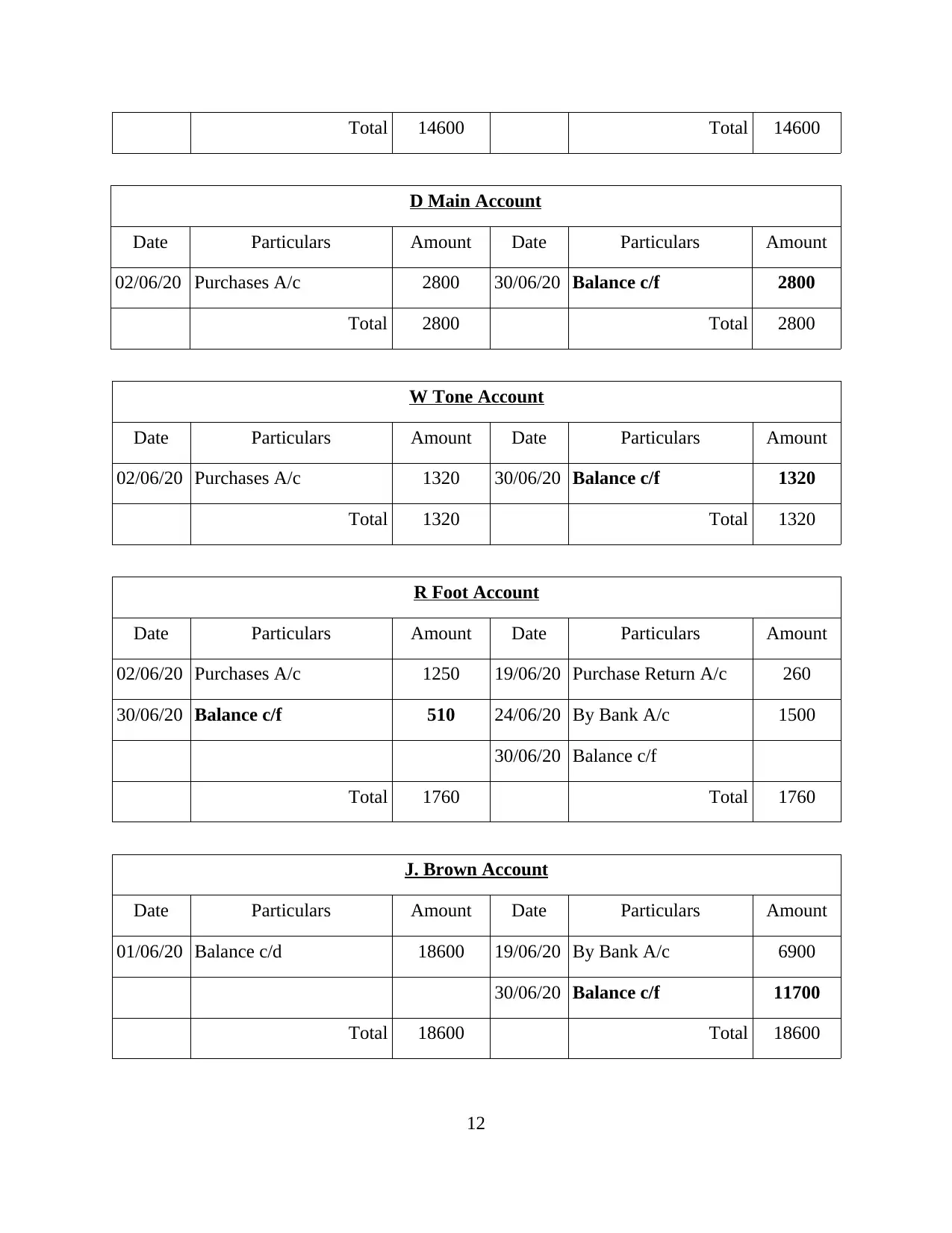
Total 14600 Total 14600
D Main Account
Date Particulars Amount Date Particulars Amount
02/06/20 Purchases A/c 2800 30/06/20 Balance c/f 2800
Total 2800 Total 2800
W Tone Account
Date Particulars Amount Date Particulars Amount
02/06/20 Purchases A/c 1320 30/06/20 Balance c/f 1320
Total 1320 Total 1320
R Foot Account
Date Particulars Amount Date Particulars Amount
02/06/20 Purchases A/c 1250 19/06/20 Purchase Return A/c 260
30/06/20 Balance c/f 510 24/06/20 By Bank A/c 1500
30/06/20 Balance c/f
Total 1760 Total 1760
J. Brown Account
Date Particulars Amount Date Particulars Amount
01/06/20 Balance c/d 18600 19/06/20 By Bank A/c 6900
30/06/20 Balance c/f 11700
Total 18600 Total 18600
12
D Main Account
Date Particulars Amount Date Particulars Amount
02/06/20 Purchases A/c 2800 30/06/20 Balance c/f 2800
Total 2800 Total 2800
W Tone Account
Date Particulars Amount Date Particulars Amount
02/06/20 Purchases A/c 1320 30/06/20 Balance c/f 1320
Total 1320 Total 1320
R Foot Account
Date Particulars Amount Date Particulars Amount
02/06/20 Purchases A/c 1250 19/06/20 Purchase Return A/c 260
30/06/20 Balance c/f 510 24/06/20 By Bank A/c 1500
30/06/20 Balance c/f
Total 1760 Total 1760
J. Brown Account
Date Particulars Amount Date Particulars Amount
01/06/20 Balance c/d 18600 19/06/20 By Bank A/c 6900
30/06/20 Balance c/f 11700
Total 18600 Total 18600
12
⊘ This is a preview!⊘
Do you want full access?
Subscribe today to unlock all pages.

Trusted by 1+ million students worldwide
1 out of 22
Related Documents
Your All-in-One AI-Powered Toolkit for Academic Success.
+13062052269
info@desklib.com
Available 24*7 on WhatsApp / Email
![[object Object]](/_next/static/media/star-bottom.7253800d.svg)
Unlock your academic potential
Copyright © 2020–2025 A2Z Services. All Rights Reserved. Developed and managed by ZUCOL.





